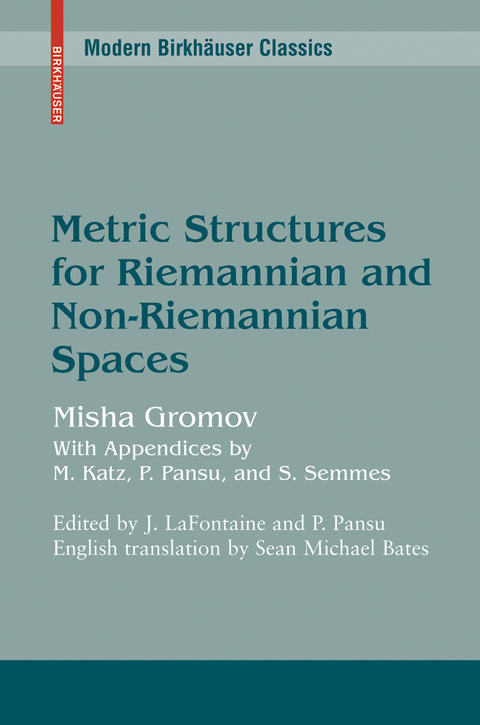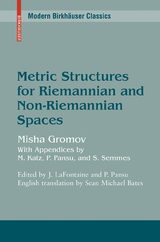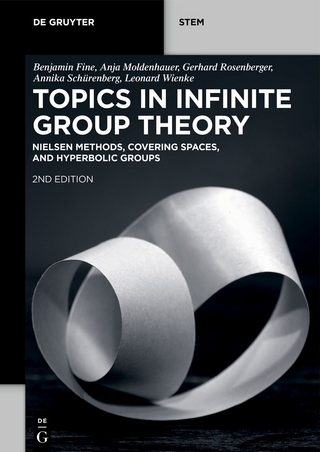Metric Structures for Riemannian and Non-Riemannian Spaces
Seiten
2006
|
1st ed. 1999. Corr. 2nd printing 2001. 3rd printing 2006
Birkhauser Boston Inc (Verlag)
978-0-8176-4582-3 (ISBN)
Birkhauser Boston Inc (Verlag)
978-0-8176-4582-3 (ISBN)
This book is an English translation of the famous "Green Book" by Lafontaine and Pansu (1979). It has been enriched and expanded with new material to reflect recent progress.
Metric theory has undergone a dramatic phase transition in the last decades when its focus moved from the foundations of real analysis to Riemannian geometry and algebraic topology, to the theory of infinite groups and probability theory.
The new wave began with seminal papers by Svarc and Milnor on the growth of groups and the spectacular proof of the rigidity of lattices by Mostow. This progress was followed by the creation of the asymptotic metric theory of infinite groups by Gromov.
The structural metric approach to the Riemannian category, tracing back to Cheeger's thesis, pivots around the notion of the Gromov–Hausdorff distance between Riemannian manifolds. This distance organizes Riemannian manifolds of all possible topological types into a single connected moduli space, where convergence allows the collapse of dimension with unexpectedly rich geometry, as revealed in the work of Cheeger, Fukaya, Gromov and Perelman. Also, Gromov found metric structure within homotopy theory and thus introduced new invariants controlling combinatorial complexity of maps and spaces, such as the simplicial volume, which is responsible for degrees of maps between manifolds. During the same period, Banach spaces and probability theory underwent a geometric metamorphosis, stimulated by the Levy–Milman concentration phenomenon, encompassing the law of large numbers for metric spaces with measures and dimensions going to infinity.
The first stages of the new developments were presented in Gromov's course in Paris, which turned into the famous "Green Book" by Lafontaine and Pansu (1979). The present English translation of that work has been enriched and expanded with new material to reflect recent progress. Additionally, four appendices – by Gromov on Levy's inequality, by Pansu on "quasiconvex" domains, by Katz on systoles of Riemannian manifolds, and by Semmes overviewing analysis on metric spaces with measures – as well as an extensive bibliographyand index round out this unique and beautiful book.
Metric theory has undergone a dramatic phase transition in the last decades when its focus moved from the foundations of real analysis to Riemannian geometry and algebraic topology, to the theory of infinite groups and probability theory.
The new wave began with seminal papers by Svarc and Milnor on the growth of groups and the spectacular proof of the rigidity of lattices by Mostow. This progress was followed by the creation of the asymptotic metric theory of infinite groups by Gromov.
The structural metric approach to the Riemannian category, tracing back to Cheeger's thesis, pivots around the notion of the Gromov–Hausdorff distance between Riemannian manifolds. This distance organizes Riemannian manifolds of all possible topological types into a single connected moduli space, where convergence allows the collapse of dimension with unexpectedly rich geometry, as revealed in the work of Cheeger, Fukaya, Gromov and Perelman. Also, Gromov found metric structure within homotopy theory and thus introduced new invariants controlling combinatorial complexity of maps and spaces, such as the simplicial volume, which is responsible for degrees of maps between manifolds. During the same period, Banach spaces and probability theory underwent a geometric metamorphosis, stimulated by the Levy–Milman concentration phenomenon, encompassing the law of large numbers for metric spaces with measures and dimensions going to infinity.
The first stages of the new developments were presented in Gromov's course in Paris, which turned into the famous "Green Book" by Lafontaine and Pansu (1979). The present English translation of that work has been enriched and expanded with new material to reflect recent progress. Additionally, four appendices – by Gromov on Levy's inequality, by Pansu on "quasiconvex" domains, by Katz on systoles of Riemannian manifolds, and by Semmes overviewing analysis on metric spaces with measures – as well as an extensive bibliographyand index round out this unique and beautiful book.
Preface to the French Edition.- Preface to the English Edition.- Introduction: Metrics Everywhere.- Length Structures: Path Metric Spaces.- Degree and Dilatation.- Metric Structures on Families of Metric Spaces.- Convergence and Concentration of Metrics and Measures.- Loewner Rediscovered.- Manifolds with Bounded Ricci Curvature.- Isoperimetric Inequalities and Amenability.- Morse Theory and Minimal Models.- Pinching and Collapse.- Appendix A: 'Quasiconvex' Domains in Rn.- Appendix B: Metric Spaces and Mappings Seen at Many Scales.- Appendix C: Paul Levy's Isoperimetric Inequality.- Appendix D: Systolically Free Manifolds.- Bibliography.- Glossary of Notation.- Index.
| Reihe/Serie | Modern Birkhäuser Classics |
|---|---|
| Mitarbeit |
Anhang von: M. Katz, Pierre Pansu |
| Übersetzer | S.M. Bates |
| Zusatzinfo | XX, 586 p. 100 illus. |
| Verlagsort | Secaucus |
| Sprache | englisch |
| Maße | 156 x 235 mm |
| Themenwelt | Mathematik / Informatik ► Mathematik ► Geometrie / Topologie |
| ISBN-10 | 0-8176-4582-9 / 0817645829 |
| ISBN-13 | 978-0-8176-4582-3 / 9780817645823 |
| Zustand | Neuware |
| Haben Sie eine Frage zum Produkt? |
Mehr entdecken
aus dem Bereich
aus dem Bereich
Gekrümmte Kurven und Flächen
Buch | Softcover (2024)
De Gruyter (Verlag)
CHF 76,90
Nielsen Methods, Covering Spaces, and Hyperbolic Groups
Buch | Softcover (2024)
De Gruyter (Verlag)
CHF 153,90




